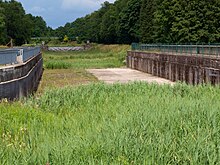Münster-Gelmer canal overpass
The canal overpass near Münster-Gelmer is an important industrial monument from the late 19th century. It made it possible to transfer the "old journey" of the Dortmund-Ems Canal over the Ems in the immediate vicinity of Gelmer . Due to the regional reform in North Rhine-Westphalia on January 1, 1975, the building has been partly on the territory of the city of Münster and the other part on that of the city of Greven , since the city limits are now the course of the river in this area.
history
Old canal flyover
The canal overpass was built between 1893 and 1897 as part of the construction of the Dortmund-Ems Canal. Since the canal was 18 m wide and 2.5 m deep for ships weighing up to 600 t, the structure had to be designed accordingly. For this purpose, the crossing was built as a brick arch construction with a total of four arch openings, each 12.60 m wide. The concrete-based pillars and the rising masonry are made of Ibbenbüren sandstone , the arches themselves were clinkered and then poured with concrete. All visible surfaces were clad with Ruhr sandstone . The overpass was decorated on both sides with bridge towers, which remained in place until the late 1930s. To seal the fairway, it was laid out with lead plates. The structure was manufactured by Bernhard Liebold from Holzminden, which built bridges across Europe, including the Friedensbrücke in Plauen with the largest arch in the world.
After the end of the First World War , the canal overpass was no longer able to cope with the requirements; in 1939 it was replaced by a "new trip" with a modified canal overpass. After their completion, both were briefly in parallel operation. In the night of August 12th to 13th, 1940, the structure was attacked by five Allied bombers. It got a direct hit. The canal water poured into the Ems, but leakage of the canal could be prevented by closing the lock gate located about 200 m to the northeast. The damaged area was then repaired with concrete, but the overpass has not been used since then and only served as a reserve for smaller ships. The repair area on the southeast side can still be clearly seen today, debris is still in the river bed, the v. a. can be visible at low water of the Ems.
After the Second World War , the "old route" was separated from the new route in this area by a dam. Thus the old canal overpass also lost its reserve function. In the mid-1990s, the water was drained from the overpass to allow restoration. Due to a lack of money, it has not yet been possible to begin with it, as the building is required to be flooded in the monument protection regulations and ensuring the tightness of the overpass causes additional costs.
New canal overpass
The "New Drive" with the new canal overpass as a steel trough structure was built in 1939 a few meters further northwest. At the same time, the service water level was raised by 0.40 m so that larger ships could pass the Dortmund-Ems Canal.
As part of the expansion of the southern stretch of the Dortmund-Ems Canal for large motor ships up to 110.00 m in length and with push convoys up to 185.00 m long, 11.40 m wide and a discharge depth of up to 2.80 m ( waterway class Vb) the "new trip" will be expanded again from 2015. The canal overpass will be rebuilt in a double trough construction, within the framework of which a trough will be built to the west of the current overpass before it is torn down and replaced by a second trough. The two locking gates will then be dismantled, both troughs will be fitted with revision locks and can be drained individually. In order to maintain shipping on the Dortmund-Ems Canal during the four-year construction work, a diversion route will be set up north of the canal, which will be preserved in parts as a leisure area after the completion of the new route and through a viewing platform and an island in the area of its intersection with the Old ride should be supplemented.
gallery
literature
- Franz Mühlen: Waterways in Westphalia . Westfälischer Heimatbund, Münster 1980, pp. 26–30: The canal overpasses over Lippe, Stever and Ems .
- Atlas for the journal for construction . Vol. LI, Berlin 1901 Plate 65, 69. Download from the Central and State Library Berlin
Web links
- Information on the canal overpass at geschichtsspuren.de (formerly lostplaces.de)
- Information from the Datteln waterways construction office on the expansion of the canal in the area of the canal overpass (PDF file; 1.02 MB)
Coordinates: 52 ° 2 ′ 24.5 " N , 7 ° 40 ′ 49.5" E





